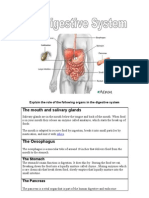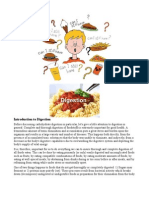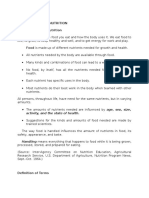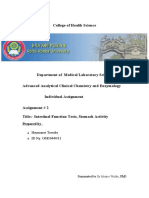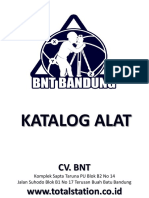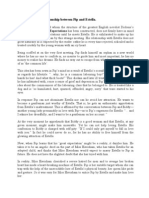0 ratings0% found this document useful (0 votes)
25 viewsEmailing DOC-20221223-WA0031.
Emailing DOC-20221223-WA0031.
Uploaded by
Laway WilayatulhaqThis document provides information about a teacher named Ajaz Ahmad Laway who is teaching a project on the digestive system to students. The project aims to break down concepts of gastroenterology into simpler terms for students to better understand. It includes introductory activities on the digestive system, a diagram of the digestive system, a worksheet on pathologies, and group and individual activities on the process of digestion. The project is intended to provide comprehensive knowledge on gastroenterology and maintaining a healthy digestive system through diet, lifestyle, food hygiene and preventing digestive issues.
Copyright:
© All Rights Reserved
Available Formats
Download as PDF, TXT or read online from Scribd
Emailing DOC-20221223-WA0031.
Emailing DOC-20221223-WA0031.
Uploaded by
Laway Wilayatulhaq0 ratings0% found this document useful (0 votes)
25 views4 pagesThis document provides information about a teacher named Ajaz Ahmad Laway who is teaching a project on the digestive system to students. The project aims to break down concepts of gastroenterology into simpler terms for students to better understand. It includes introductory activities on the digestive system, a diagram of the digestive system, a worksheet on pathologies, and group and individual activities on the process of digestion. The project is intended to provide comprehensive knowledge on gastroenterology and maintaining a healthy digestive system through diet, lifestyle, food hygiene and preventing digestive issues.
Copyright
© © All Rights Reserved
Available Formats
PDF, TXT or read online from Scribd
Share this document
Did you find this document useful?
Is this content inappropriate?
This document provides information about a teacher named Ajaz Ahmad Laway who is teaching a project on the digestive system to students. The project aims to break down concepts of gastroenterology into simpler terms for students to better understand. It includes introductory activities on the digestive system, a diagram of the digestive system, a worksheet on pathologies, and group and individual activities on the process of digestion. The project is intended to provide comprehensive knowledge on gastroenterology and maintaining a healthy digestive system through diet, lifestyle, food hygiene and preventing digestive issues.
Copyright:
© All Rights Reserved
Available Formats
Download as PDF, TXT or read online from Scribd
Download as pdf or txt
0 ratings0% found this document useful (0 votes)
25 views4 pagesEmailing DOC-20221223-WA0031.
Emailing DOC-20221223-WA0031.
Uploaded by
Laway WilayatulhaqThis document provides information about a teacher named Ajaz Ahmad Laway who is teaching a project on the digestive system to students. The project aims to break down concepts of gastroenterology into simpler terms for students to better understand. It includes introductory activities on the digestive system, a diagram of the digestive system, a worksheet on pathologies, and group and individual activities on the process of digestion. The project is intended to provide comprehensive knowledge on gastroenterology and maintaining a healthy digestive system through diet, lifestyle, food hygiene and preventing digestive issues.
Copyright:
© All Rights Reserved
Available Formats
Download as PDF, TXT or read online from Scribd
Download as pdf or txt
You are on page 1of 4
INTRODUCTION:
NAME:AJAZ AHMAD LAWAY
DESIGNATION:TEACHER
PLACE OF POSTING:GOVERNMENT MIDDLE SCHOOL SHOWGUND MALWAN
EDUCATION ZONE:KULGAM
SCHOOL COMPLEX HEAD:GOVERNMENT HIGHER SECONDARY SCHOOL MALWAN
R/O and P/O:MALWAN Tehsil:Pehloo District:KULGAM UT:JAMMU AND KASHMIR
PROJECT NAME:DIGESTIVE SYSTEM OF MAN.
OBJECTIVE: Deconstruct Standards (COMPREHENSIVE SCIENCE CONCEPT
GASTROENTELOGY) into student friendly language for better understanding.
ACTION STEPS:
01.INTRODUCTORY ACTIVITY (VIDEOS OF GASTROENTEROLOGY
BY GASTROENTEROLOGISTS) OF MODERN WORLD.
THE DIGESTIVE SYSTEM
The Digestive System runs from the mouth to the anus and includes the stomach, the large and small intestines and a number of
accessory organs, including the salivary glands, liver, gallbladder and pancreas. The role of the digestive system is to turn food and liquid
into the building blocks that the body needs to function effectively. To do this it produces and utilises a variety of enzymes and other
substances that aid digestion (breaking food down to smaller molecules).
Food takes around two hours to pass through the stomach, two hours to pass through the small intestine and 20 hours through the large
intestine and into the rectum; the length of the digestive tube from mouth to anus is 9 metres on average. Approximately seven litres of
fluid are secreted by the digestive system and its accessory organs each day. It is important to note that the words ‘intestine’ and ‘bowel’
are interchangeable. When the system works correctly, food is broken down so that nutrients can be absorbed and unwanted products
excreted. When one or more of the functions of the digestive system fail, symptoms and disease can develop.There are many different
processes which contribute to a functioning and effective digestive system:
Ingestion (putting food in your mouth)
Mechanical digestion (chewing and food being churned inside the digestive tract)
Chemical digestion (digestive enzymes and substances breaking food down)
Absorption (molecules passing from digestive system into the body)
Making and passing stools (faeces)
KEY COMPONENTS OF THE DIGESTIVE SYSTEM
Mouth: the beginning of the digestive tract. Food is put into the mouth and broken down by chewing. This is called mechanical digestion.
Various enzymes are secreted to help this breakdown, including saliva or ‘salivary amylase’ which is involved in digestion of
carbohydrates to smaller chains and simple sugars. This is called chemical digestion
Oesophagus: ingested food is swallowed and transported from the mouth to the stomach by the oesophagus
Stomach: churning and mixing motions occur here due to muscle contractions, continuing the process of mechanical digestion. In addition,
chemical digestion occurs in the stomach. The food is mixed with gastric juices and many digestive enzymes to help break down
carbohydrates, proteins and fats. Hydrochloric acid is also released which provides an acidic environment to help enzymes work and
also kills some unwanted bacteria.
Small intestine: the main function of the small intestine is absorption of nutrients and minerals. About 90% of digestion and absorption occurs
here including the digestion of proteins, fats and carbohydrates. Food is moved through the small intestine by co-ordinated contractions
(called peristalsis) of the intestine wall which occur in a wave pattern travelling down from one section to the next. The contractions occur
behind the ball of food (bolus), forcing it through the digestive system.
Large intestine: the main function of the large intestine is to remove water from its contents. This hardens the stool so it can be excreted
from the body via the rectum and anus.
Accessory organs: the liver has many functions which include help with digesting food, storing fuel for the body (glycogen), helping the blood
to clot, and removing or processing alcohol, toxins and medications from the body. The liver also makes bile, which is stored in the
gallbladder before passing into the small intestine, where it aids in fat digestion. The pancreas has two main functions: the production of
digestive enzymes, which pass into the small intestine to help the chemical digestion of food, and the production of certain hormones,
such as insulin, which help control blood sugar levels
02 “Diagram of the Digestive System” provided to students(figure 1.1).
03.“Pathologies of the Digestive System” worksheet.
04. Group Activity: “Process of Digestion”
O5.Discussion of Group Activity.
06.Independent Assessment.
IMPACT:By this methodology the students would be able to get comprehensive
knowledge about GASTROENTEROLOGY which reads as under:
01.To maintain good health, including a healthy digestive system, it is important to follow a balanced healthy
diet that includes a range of foods. It is also important to make lifestyle changes such as avoiding smoking
and keeping active.
02.PREVENTING DIGESTIVE PROBLEMS
Some digestive diseases have genetic components, and others may occur for unknown reasons. But many
disorders of the digestive system can be prevented or minimized with simple solutions, like changing your
diet or exercise habits.
03.WHY IS HEALTHY EATING IMPORTANT?
Eating a healthy and varied diet can improve general well-being. Good nutrition is essential to obtain the
nutrients to keep the body healthy as well as avoiding substances that may be harmful. Having a healthy
diet and doing regular exercise can help to achieve and maintain a healthy body weight. A healthy diet is
also important to help reduce the risk of developing certain long-term diseases such as diabetes, heart
disease and strokes. Additionally, it may reduce the risk of developing certain cancers and types of
dementia. Conversely a poor diet can lead to weight gain and can lead to increased risk of developing
certain long-term diseases. Any of these health conditions can lead to a poor quality of life and other health
complications, which can eventually result in a decreased life expectancy.
04.HOW IMPORTANT IS FOOD HYGIENE?
Poor hygiene can certainly increase your chance of getting food poisoning. Food poisoning is usually a
short-lived illness but it can be very unpleasant while it lasts. Always wash your hands after visiting the toilet
and before handling food. Care should b
e taken with storage of food, particularly in hot weather. Certain foods, especially raw meat, must be kept
covered, separated from other foods and well refrigerated. It is best practice to follow the guidance provided
by food manufacturers’ ‘use by’ and ‘best before’ dates. While some of these are used to specify when the
food will be at its best, it can be risky to eat meat after the stated date. When re-heating food, make sure it
is hot all the way through (e.g. into the middle of a pie or down to the bone in a chicken leg) to kill all bacteria:
if it’s cold or you can see blood, don’t eat it. This is particularly important when using a microwave oven or
a barbecue.
05.What is the impact on the gut and on general health of some of the most popular diets?
06.How do our diet and gut bacteria interact and how does that interaction affect our gut and general health?
07How does diet and specific food components affect appetite and satiety (feeling of fullness)?
08.How do dietary requirements change as we age?
09.How does diet interact with physical activity and how does that interaction affect our gut and general
health?
10.How does diet affect the risk of developing some diseases?
11.What are the links between food and mood?
12.Why do some people gain weight more easily than others?
13.Do food preservatives and other components of processed foods play a role in gut health, general health
or weight gain?
You might also like
- Overview of The Digestive SystemDocument9 pagesOverview of The Digestive SystemMehmet SaylıkNo ratings yet
- EnzymesDocument9 pagesEnzymesatkalčić100% (1)
- Project Comparison of Amul Milk and Mother Dairy Milk 15 March 2014Document47 pagesProject Comparison of Amul Milk and Mother Dairy Milk 15 March 2014jain2007gaurav58% (53)
- Mathematics in The Modern World Problem Set Preliminary PeriodDocument2 pagesMathematics in The Modern World Problem Set Preliminary PeriodMikay.No ratings yet
- The Digestive System:, Into Your Small IntestineDocument4 pagesThe Digestive System:, Into Your Small IntestineHazean Agustin-DatoyNo ratings yet
- Digestive SystemDocument15 pagesDigestive SystemAlicia ValverdeNo ratings yet
- Laboratory Food Digestion Lumiguid 1Document7 pagesLaboratory Food Digestion Lumiguid 1Carea CruzNo ratings yet
- 1624540931digestion and DetoxificationDocument15 pages1624540931digestion and DetoxificationAyoub ChiropracticNo ratings yet
- First Pillar of Integrative HealthDocument11 pagesFirst Pillar of Integrative HealthMus OubNo ratings yet
- Digestive System ReviewerDocument6 pagesDigestive System ReviewerElieNo ratings yet
- Digestive SystemDocument2 pagesDigestive Systemjellyngan1022No ratings yet
- Diet Assessment 2Document6 pagesDiet Assessment 2NorrisRyanNo ratings yet
- Nutrition-GSCI1045 Lecture - Week 4Document12 pagesNutrition-GSCI1045 Lecture - Week 4Nicholas ObasiNo ratings yet
- What Is The Digestive System?Document4 pagesWhat Is The Digestive System?Abubakker SiddiqNo ratings yet
- Digestive System Grade 4 (1)Document41 pagesDigestive System Grade 4 (1)aileenmalayaoNo ratings yet
- KlingDocument4 pagesKlingKlingot Mc DigheelsNo ratings yet
- How Is Food DigestedDocument12 pagesHow Is Food DigestedNationalKidNo ratings yet
- Digestive system class printsDocument10 pagesDigestive system class printskfrancis.chhsNo ratings yet
- The Healthy Gut Bible 4 Books in 1: The Healthy Gut, The Healthy Gut Cookbook, The Ultimate Leaky Gut Health Guide and 7 Days DetoxFrom EverandThe Healthy Gut Bible 4 Books in 1: The Healthy Gut, The Healthy Gut Cookbook, The Ultimate Leaky Gut Health Guide and 7 Days DetoxNo ratings yet
- Human Digestive SystemDocument25 pagesHuman Digestive SystemVivek JainNo ratings yet
- 2.6 Digestive SystemDocument3 pages2.6 Digestive SystemOke AdasenNo ratings yet
- Food and Nutrient DigestionDocument34 pagesFood and Nutrient DigestionvinodhknatrajanNo ratings yet
- Study of The Human Digestive SystemDocument11 pagesStudy of The Human Digestive Systemchess accNo ratings yet
- carbohydrates-gut-health-pdfDocument15 pagescarbohydrates-gut-health-pdfmaria.mNo ratings yet
- DigestionDocument22 pagesDigestionapi-200177496No ratings yet
- PHYSIOLOGY OF DIGESTION Lec 7Document22 pagesPHYSIOLOGY OF DIGESTION Lec 7Laiba NaeemNo ratings yet
- Digestive System: Guided Notes & WorksheetDocument4 pagesDigestive System: Guided Notes & WorksheetAngelica Carrillo-Contreras100% (1)
- Digestion: The Good, The Bad, and The DirtyDocument43 pagesDigestion: The Good, The Bad, and The DirtyPatrícia Vieira100% (4)
- Basic Concepts of NutritionDocument23 pagesBasic Concepts of NutritionMarie Nelle Escriba Limpoco50% (2)
- Digestion in HumansDocument61 pagesDigestion in HumansCharlene DinawanaoNo ratings yet
- The Complete Guide to Health: How to Improve Digestion and Boost Your Well-beingFrom EverandThe Complete Guide to Health: How to Improve Digestion and Boost Your Well-beingNo ratings yet
- Healthy Gut: Simple Steps and Recipes to Keep Your Gut HappyFrom EverandHealthy Gut: Simple Steps and Recipes to Keep Your Gut HappyRating: 5 out of 5 stars5/5 (4)
- Sana Ahmed DigestiveDocument8 pagesSana Ahmed DigestiveDlzar AbubakrNo ratings yet
- "The Digestive System of The Body": Rizal Technological University Boni Avenue, MandaluyongDocument5 pages"The Digestive System of The Body": Rizal Technological University Boni Avenue, MandaluyongMark TumaliuanNo ratings yet
- LEARNING DIARY FOR NCM 105n/L-Nutrition and Diet Therapy Date: Name: Topics: Guide QuestionsDocument3 pagesLEARNING DIARY FOR NCM 105n/L-Nutrition and Diet Therapy Date: Name: Topics: Guide QuestionsWendell Gian GolezNo ratings yet
- Healthy Gut A Guide To Gut HealthDocument20 pagesHealthy Gut A Guide To Gut HealthKaaptan Imran khan Words0% (1)
- Digestive System #3Document10 pagesDigestive System #3Roosebel De Tauro SantiagoNo ratings yet
- The Digestive SystemDocument7 pagesThe Digestive SystemnurmeenNo ratings yet
- What Is The Digestive System?: Why Is Digestion Important?Document4 pagesWhat Is The Digestive System?: Why Is Digestion Important?Sherlyna YolandaNo ratings yet
- Digestive System: Name: Azza Ferista Delvia Ninda Sa Ri O Kta Imelda Ikhda La Tifatun Naim Cla SS: 4BDocument7 pagesDigestive System: Name: Azza Ferista Delvia Ninda Sa Ri O Kta Imelda Ikhda La Tifatun Naim Cla SS: 4BMaulana RifkiNo ratings yet
- The Digestive and Endocrine SystemDocument86 pagesThe Digestive and Endocrine SystemGerald SouribioNo ratings yet
- Diet Assessment NBDocument6 pagesDiet Assessment NBnbaker2108No ratings yet
- Digestive System: Submitted By: Caimoso, Tricia Ann D. Quiambao, Aliyah Lourdes D. Bs Psychology 3-3Document9 pagesDigestive System: Submitted By: Caimoso, Tricia Ann D. Quiambao, Aliyah Lourdes D. Bs Psychology 3-3Tricia Ann CaimosoNo ratings yet
- Assignment Number Two The Gastrointestinal TractDocument13 pagesAssignment Number Two The Gastrointestinal TractHABTAMU MOLLANo ratings yet
- 3 2 2 Student Response SheetDocument4 pages3 2 2 Student Response Sheetapi-262497675No ratings yet
- Tarea de InglesDocument3 pagesTarea de InglesNatali de los santosNo ratings yet
- NUTRITIONDocument40 pagesNUTRITIONShene Claire VigillaNo ratings yet
- Nutrition and DietDocument16 pagesNutrition and DietSherwan R ShalNo ratings yet
- Nutrition DietaryDocument35 pagesNutrition DietaryAbdul Quyyum100% (2)
- Digestive Sysytem: Basic Health CareDocument50 pagesDigestive Sysytem: Basic Health CareBecky GalanoNo ratings yet
- The Liver Healing Diet: The Nutritional Plan to Fight Toxins, Reverse Fatty Liver Disease and Promote Good HealthFrom EverandThe Liver Healing Diet: The Nutritional Plan to Fight Toxins, Reverse Fatty Liver Disease and Promote Good HealthNo ratings yet
- The Digestive SystemDocument10 pagesThe Digestive Systemapi-272920130No ratings yet
- Basic Nutrition Chapt 1 2022Document59 pagesBasic Nutrition Chapt 1 2022a.joshuaNo ratings yet
- Examen Final de InglesDocument3 pagesExamen Final de InglesCynthia SaldañaNo ratings yet
- Science Reviewer - Digestive SystemDocument4 pagesScience Reviewer - Digestive SystemCarlieseNo ratings yet
- Digestive System Explained - Better Health ChannelDocument4 pagesDigestive System Explained - Better Health Channeljyotimahto355No ratings yet
- Robby Ackles Jalen Chuang Miles Goodman - Digestive System LessonDocument16 pagesRobby Ackles Jalen Chuang Miles Goodman - Digestive System Lessonapi-264394835No ratings yet
- Presentation 19Document45 pagesPresentation 19domafecaluyoNo ratings yet
- Digestive SystemDocument26 pagesDigestive SystemFrancisco D. AndaquigNo ratings yet
- Human Digestive SystemDocument21 pagesHuman Digestive Systemwadhwacommunisation0001No ratings yet
- Curs Nutritie Rezumat - Part 1Document10 pagesCurs Nutritie Rezumat - Part 1Leordean VeronicaNo ratings yet
- Catalog Alat CV - BNTDocument115 pagesCatalog Alat CV - BNTdenisNo ratings yet
- Non Metallic MaterialDocument10 pagesNon Metallic MaterialVinoth Rengaraj100% (1)
- Predator Prey ModelDocument5 pagesPredator Prey ModelAbdul Manaf100% (1)
- Final Exam Time Table - Iii To Ix & XiDocument2 pagesFinal Exam Time Table - Iii To Ix & Ximontfort.blessingdayNo ratings yet
- RFP Caste Based Survey BSEDCDocument138 pagesRFP Caste Based Survey BSEDCসাম্য মুখার্জীNo ratings yet
- 6 Semester MGU Cost Accounting 2016 March Question PaperDocument4 pages6 Semester MGU Cost Accounting 2016 March Question PaperRainy GoodwillNo ratings yet
- Advanced Painting Techniques PDFDocument40 pagesAdvanced Painting Techniques PDFFran100% (9)
- Infant and Toddler Concussion Guide: Signs & SymptomsDocument2 pagesInfant and Toddler Concussion Guide: Signs & Symptomspeninah annNo ratings yet
- Global Business StrategyDocument41 pagesGlobal Business StrategyTeffi Boyer Montoya100% (1)
- Balance Torsion Type 790A PDFDocument4 pagesBalance Torsion Type 790A PDFDarwin Newton TacoraNo ratings yet
- Adventist University of The Philippines College of Medicine Update Jan14.2014finalDocument7 pagesAdventist University of The Philippines College of Medicine Update Jan14.2014finalLaurence Tabanao GayaoNo ratings yet
- Gender Identity DisorderDocument12 pagesGender Identity Disorderapi-3764215No ratings yet
- Turunan Peraturan Presiden Nomor 8 Tahun 2012 Tentang KKNI: Issuer Regulation (Number/Year) Subject Government GovernmentDocument3 pagesTurunan Peraturan Presiden Nomor 8 Tahun 2012 Tentang KKNI: Issuer Regulation (Number/Year) Subject Government GovernmentDedi Budi SetiawanNo ratings yet
- Chapter 4: AC Circuits: 2076 Set B Q.No.1 2070 Set C Q.No.1 220 V A.C. Is More Dangor Than 220 V D.C., Why?Document21 pagesChapter 4: AC Circuits: 2076 Set B Q.No.1 2070 Set C Q.No.1 220 V A.C. Is More Dangor Than 220 V D.C., Why?Suraj Bhandari100% (1)
- 09 - XML SchemaDocument18 pages09 - XML SchemaKhoirul MunaNo ratings yet
- College Management SystemDocument4 pagesCollege Management SystemYO BOY'SNo ratings yet
- 6T30 6T40Document8 pages6T30 6T40Fabiano Silva AzechiNo ratings yet
- Lab Centre of Pressure Ecw341Document4 pagesLab Centre of Pressure Ecw341danialNo ratings yet
- Adjective Phrase - AppositiveDocument1 pageAdjective Phrase - AppositiveenkhsaikhanNo ratings yet
- ECO701 Economics and The Business EnvironmentDocument17 pagesECO701 Economics and The Business EnvironmentSrijita SahaNo ratings yet
- A Short Study On Launching Techniques: April 2015Document16 pagesA Short Study On Launching Techniques: April 2015raaaaajjjjjNo ratings yet
- JENESYS ProgrammeDocument17 pagesJENESYS ProgrammeSophearin PhannNo ratings yet
- Development of Relationship Between Pip & EstellaDocument2 pagesDevelopment of Relationship Between Pip & EstellaMiah Rashiduzzaman79% (14)
- نصاب الصرف FinalDocument87 pagesنصاب الصرف FinalAneeka SyedNo ratings yet
- BLM Thesis MapDocument5 pagesBLM Thesis Mapapi-240827612No ratings yet
- Dev SharmaDocument66 pagesDev SharmaManya KhannaNo ratings yet
- Zoom G2.1u English ManualDocument25 pagesZoom G2.1u English ManualKevin KerberNo ratings yet
- Awaji AnalysisDocument65 pagesAwaji AnalysisVania Estrellita0% (1)












